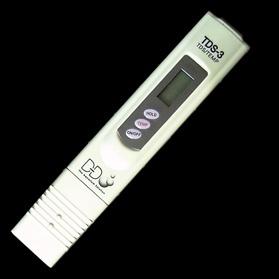TDS stands for Total Dissolved Solids, what this means in real terms is that a TDS meter will measure all negative (anions) and positively charged ions (cations) that are present in water.
These ions may include Calcium, Sodium, Magnesium, Phosphate, Nitrate and Silicate to name but a few. It’s important that we know the remaining concentration of these ions after tap water has passed through an RO unit. Hobbyists that use dechlorinated tap water for fresh water aquaria may also wish to evaluate the quality of their tap water to ascertain if it is of suitable quality without further treatment.
Many chemicals and pesticides make it into our tap water due to land run off, sewage and industrial activity; a high TDS reading may give an early warning to deterioration of local or seasonal tap water that may otherwise go unnoticed. Tap water standards are set to ensure that drinking water is of a sufficiently high quality that it can be consumed by humans, unfortunately the TDS of raw tap water is often far too high to maintain water quality for sensitive aquaria. It is not uncommon for U.K tap water to contain TDS of between 100-500 ppm!!
Although Ro units are extremely efficient at removing unwanted ions from water residual amounts of very small compounds such as ammonia and silicate can still find their way through the minute pore size of the membrane . These compounds can harm sensitive fishes and invertebrates as well as provide nutrients for unsightly algae. A high RO water TDS reading of over 5 ppm will indicate that these ions could be present and indicate that a Di pod post membrane will be required for complete ion removal.
All TFM (Thin film membrane) membrane RO units typically have a rejection rate of between 96-98%; the resulting water is usually pure enough with a TDS reading below 5 ppm to be used for aquaria without further treatment. This is fine if you live in an area with reasonable tap water quality but if you live in an area where tap water has a TDS of say 450 ppm you may still find significant levels of TDS of around 16 ppm due to the rejection rate factor.
For this reason we highly recommend that tap water and RO effluent TDS is regularly monitored with either a D-D hand held or inline TDS meter. If you find that your RO effluent TDS is high due to high tap water TDS we also supply deionising pods for complete removal of TDS, the Di resin will become exhausted with continued use so you will also need to monitor the resin and change it out when TDS starts to rise above 0.
RO membranes also become blocked over time, if the pre filters are well maintained the membranes can last for many years. Visual inspection won’t confirm when a membrane needs replacement but regularly checking the RO water TDS compared against the TDS of the tap water will indicate a faulty membrane. When this drops below 90% rejection the membrane will require replacement if flushing the membrane doesn’t improve matters.
Tips for using a TDS meter:
Avoid touching and do not damage the electrodes
Keep the electrodes clean by rinsing them in RO water, if scale builds up on the electrodes you can use a little vinegar to clean them, rinse well in RO water after cleaning.
Don’t worry if the RO unit’s effluent tds is between 0-5, the water is usually pure enough to use for aquatics, running the RO units for five minutes usually results in a drop in TDS after initial start up, flushing the membrane will also help bring down initial TDS.
If you find your Tap water TDS is high and this results in a value of over 5ppm (parts per million) TDS in your product water install a D-D Di pod for complete removal of positive and negatively charged ions. Monitor the RO output at least once a week to evaluate when the Di resin requires changing out.
Always use a clean collection vessel that is well rinsed before collecting water for testing. Minute amounts of detergent can give false high TDS readings.
Do not attempt to read the TDS of salt water for use in reef aquaria, the salt concentration will be off the scale and won’t provide any useful reading.
So to sum up a TDS meter is a cheap and invaluable tool for keeping tabs on fresh water quality both before and after Reverse osmosis treatment.
Tony
